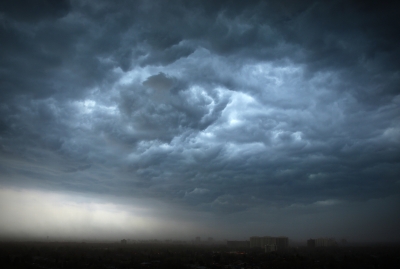Anytime a hurricane or other natural disaster is predicted to strike, it causes widespread uncertainty in the stock market. Although the people who are in the path of an upcoming storm place their focus on staying safe and protecting their homes and businesses, investors around the country pay closer attention to their investments in an attempt to determine whether or not the storm will cause them to lose money.
 The most common way to mitigate risk is through insurance but there are other methods as well. Investors can use options to help cover the risk of loss. But how does a farmer or corporation protect against loss of use of their land due to a flood, hurricane or other natural disaster? One fairly new method (since the mid-1990s) is the use of catastrophe bonds which transfer some of the risk of natural disaster to investors.
The most common way to mitigate risk is through insurance but there are other methods as well. Investors can use options to help cover the risk of loss. But how does a farmer or corporation protect against loss of use of their land due to a flood, hurricane or other natural disaster? One fairly new method (since the mid-1990s) is the use of catastrophe bonds which transfer some of the risk of natural disaster to investors.
An insurance company issues these Catastrophe Bonds (cat bonds) which are then sold to investors. If no catastrophe occurs, the insurance company pays a fairly high coupon (interest rate) to the investors, who made a healthy return. If a catastrophe does occur, then the principal would be forfeited and the insurance company would use this money to pay their claim-holders. Thus the investors are acting like an insurance company and betting that no catastrophe will occur and that they will earn a healthy return. The return has to be high enough to compensate for the possibility of a partial or total loss of the principal.
What are the Risks and Rewards of Catastrophe Bonds?
Catastrophe bonds can be an interesting investment opportunity because they typically provide investors with a very large return. In exchange for this, however, investors agree to take on the risk of potentially losing a large amount of money if a major disaster wipes out the cash reserves that the affiliated insurance companies have on hand.
Do Hurricanes Always Impact the Catastrophe Bonds Market?
Although this might sound like a risky proposition for investors, these bonds can actually provide a nice source of income over the long haul as long as you are careful about diversifying your risk and which catastrophe bonds you select. For example, Hurricane Sandy did not trigger the payout of any catastrophe bonds, and even Hurricane Katrina only caused the partial usage of one of the nine bonds that was covering the area.
Although there was a lot of discussion about the potential impact of Hurricane Isaac, there was not as much activity as some people might have expected. In fact, although there was definitely some Catastrophe Bond trading (livecat trading) leading up to the storm, the $125 million catastrophe bond that protects the Louisiana Citizens Property Insurance Company only suffered from a temporary four percent drop. Overall, though, the total amount of damage that Hurricane Isaac caused didn’t trigger the catastrophe bond to be utilized, and this quickly restored investor confidence.
Hurricane Irene sparked some livecat trading, but most people did not make any major changes to their investments. After all, catastrophe bonds are designed to protect both the insurance company and their stock holders, and it is well-known that most of the bonds will never be touched unless there is a record-breaking storm that causes an almost unfathomable amount of damage. This is the main reason that investors are willing to put their money into these bonds, and as previously mentioned, even Hurricane Katrina did not hurt most investors.
Should Catastrophe Bonds be Considered a Safe Investment?
No matter what anyone might tell you, there is truly no such thing as a totally safe investment. However, if you have enough financial resources to invest in a diversified portfolio of catastrophe bonds without losing all of your money if something goes wrong, they are a good way to generate a high return over an extended period of time. However, it is important to carefully consider the location of the catastrophe bond that you choose to invest in. For example, a bond on the East Coast will be much less likely to be impacted by a storm than a bond in Louisiana. Therefore, even though a bond in Louisiana might have a higher return rate, you wouldn’t want to put all your money into one.
See Also:
- The Five Key Investment Criteria
- The Risks and Rewards of High Dividend Stocks
- 10 Tips to Avoid Bad Investments
- Investing with DRIPs
- A Student’s Guide To Investing in Bonds
- What Are Binary Options?
- Using Forex to Hedge against Inflation
- How to Save Your Money And Your Life
Recommended from Amazon:
- A Beginner’s Guide to Investing: How to Grow Your Money the Smart and Easy Way
- The Intelligent Investor: The Definitive Book on Value Investing
- The Little Book of Common Sense Investing: The Only Way to Guarantee Your Fair Share of Stock Market Returns
- The Neatest Little Guide to Stock Market Investing: 2013 Edition
- Rich Dad’s Guide to Investing: What the Rich Invest in, That the Poor and the Middle Class Do Not!
This article was written by Troy Liebermann, a freelancer based in Cheyenne, Wyoming. Catastrophes, injuries and wrongful deaths are an unfortunate part of life; those who have to deal Wrongful Death as a result of catastrophic injury should contact a firm with significant experience in this area.
Image courtesy of George Stojkovic / FreeDigitalPhotos.net
